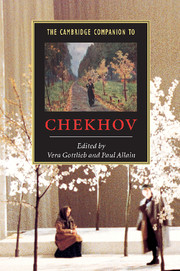Book contents
- Frontmatter
- Part 1 Chekhov in context
- Part 2 Chekhov in production
- 4 From Platonov to Piano
- 5 Chekhov's one-act plays and the full-length plays
- 6 Ivanov: the invention of a negative dramaturgy
- 7 The Seagull: an adaptation
- 8 Notes from a director: Uncle Vanya
- 9 Notes from a director: Three Sisters
- 10 The Cherry Orchard
- 11 Acting Chekhov: 'a friend to the actor'
- 12 The scenography of Chekhov
- 13 Chekhov on screen
- 14 Chekhov on the Russian stage
- 15 Directors' Chekhov
- Part 3 Chekhov the writer
- Appendix 1 Chekhov's works: primary sources from the Russian - Variations of English titles from the Russian
- Appendix 2 Selected stage productions
- Appendix 3 Selected screen versions
- Appendix 4 Illustrations
- Selected bibliography
- Index of Works by Checkov
- General Index
12 - The scenography of Chekhov
from Part 2 - Chekhov in production
Published online by Cambridge University Press: 28 May 2006
- Frontmatter
- Part 1 Chekhov in context
- Part 2 Chekhov in production
- 4 From Platonov to Piano
- 5 Chekhov's one-act plays and the full-length plays
- 6 Ivanov: the invention of a negative dramaturgy
- 7 The Seagull: an adaptation
- 8 Notes from a director: Uncle Vanya
- 9 Notes from a director: Three Sisters
- 10 The Cherry Orchard
- 11 Acting Chekhov: 'a friend to the actor'
- 12 The scenography of Chekhov
- 13 Chekhov on screen
- 14 Chekhov on the Russian stage
- 15 Directors' Chekhov
- Part 3 Chekhov the writer
- Appendix 1 Chekhov's works: primary sources from the Russian - Variations of English titles from the Russian
- Appendix 2 Selected stage productions
- Appendix 3 Selected screen versions
- Appendix 4 Illustrations
- Selected bibliography
- Index of Works by Checkov
- General Index
Summary
The stage demands a degree of artifice . . . you have no fourth wall. Besides, the stage is art, the stage reflects the quintessence of life and there is no need to introduce anything superfluous on to it.
These were Chekhov's words to an actor during the rehearsals for the Moscow Art Theatre premiere of The Seagull, and it encapsulates the ongoing struggles Chekhov would have with Stanislavsky's productions. Chekhov was a Symbolist playwright trapped in a Naturalist theatre. In his texts the settings were described with a stark, yet poetic minimalism and could be seen as part of the Symbolist project to fuse interior and exterior states of mind. For Chekhov, as for Maeterlinck whom he greatly admired, the concrete elements of the external world were manifestations of emotional states of being; what Richard Wagner called 'soul states'. The settings are virtual roadmaps to the psyche, and so complete is the identification of the character with the decor that if the setting were taken away the character would cease to exist. 'I love this house,' says Madame Ranevsky in Act Three of The Cherry Orchard. 'Without the cherry orchard my life would lose its meaning, and if it must really be sold then go and sell me with the orchard.'
- Type
- Chapter
- Information
- The Cambridge Companion to Chekhov , pp. 134 - 148Publisher: Cambridge University PressPrint publication year: 2000



